Relaxation techniques against sweating

In connection with the psychosomatic structure of hyperhidrosis, it becomes clear that the human soul and body embody an inseparable unity. A one-sided assessment of the phenomenon of hyperhidrosis would therefore be tantamount to a diagnostic fallacy.
In principle, therefore, both the psychological and the physical constitution of the affected person should be taken into account for the assessment and appreciation of a disease. In this context, it was also insistently pointed out that psychological factors experienced by affected persons with individually varying stress quality and quantity can be regarded as causative for an abnormality of the sweat gland function. Conversely, this regularity also allows the conclusion that positive - psychological and thus strengthening influences can trigger a healing effect.
Exactly this effect is the basis of many relaxation therapies. Here, by influencing the body, the psyche of the person is also addressed. Physical relaxation and rest thus also results in mental relaxation and stability. Just as psychological stress factors can exert negative effects on the human organism and cause physical cramps in particular, physical relaxation influences activate and promote mental recovery in a mirror-image way.
Since the illustrated relationships and laws of psychosomatics can also be transferred to the clinical picture of hyperhidrosis, such relaxation procedures are definitely indicated as an accompanying treatment to alleviate abnormal sweating.
Relaxation as an accompanying factor in the therapy process hyperhidrosis
Such applications have been proven to have a therapeutic support function, but as the sole and exclusive therapy of hyperhidrosis, these procedures remain mostly of limited and only minor effect.
The great advantage of these types of treatment is the simplicity of their implementation and the fact that unpleasant side effects, as they are often indicated in drug treatments, are almost excluded. .
These relaxation therapies are offered in very diverse forms , but their effects are always based on the interplay between human psyche and physique.
Among the best known relaxation methods are therapies such as:
- Bioenergetics
- progressive muscle relaxation
- Yoga or the
- relaxation according to Jacobsen
- autogenic training
The latter methodology is presented below in more detail and in its function as representative of all other relaxation exercises.
